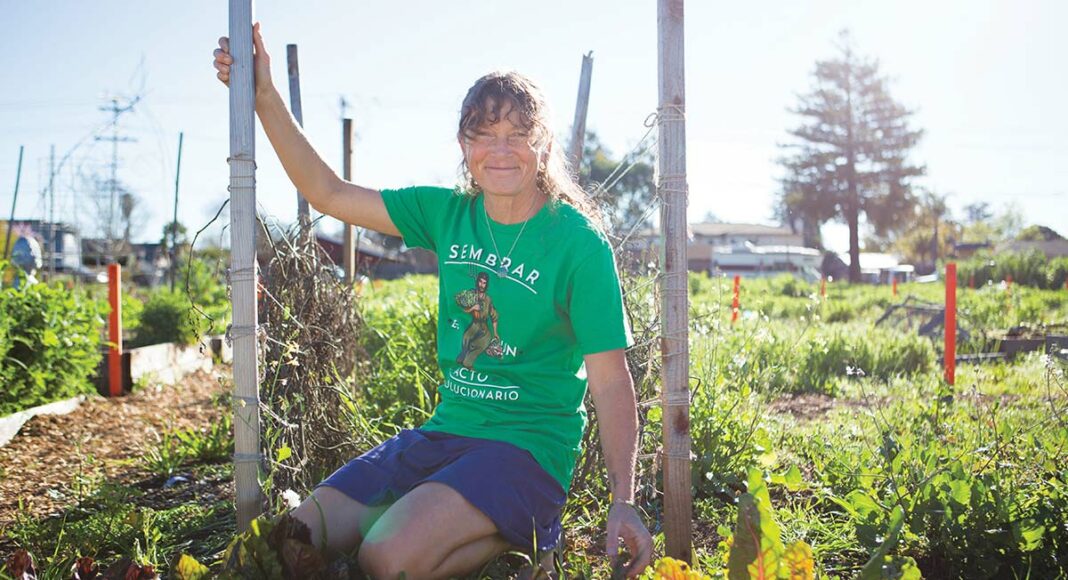Ana Rasmussen, longtime resident of a downtown Santa Cruz mobile home park, remembers waiting three years for a community garden plot for her family.
“I remember thinking, I bet there are other people like me who would like a garden but don’t have a place. That’s how this whole thing got started,” says Rasmussen.
Before she founded Mesa Verde Gardens, a nonprofit bringing shared vegetable gardens to low-income Pajaro Valley neighborhoods, Rasmussen was a social worker for two decades. Ready for a career change and with her sons grown, she apprenticed at Oakland’s City Slicker Farms and UC Santa Cruz’s Center for Agroecology and Sustainable Food Systems in 2009 and 2010.
In early 2010, Rasmussen began Mesa Verde’s first project—10 gardens at Watsonville preschools, introducing students to organic produce. After talking to parents, she realized a deeper demand: families already wanted vegetable gardens, but most lived in low-income apartments without access to soil. Rasmussen pivoted.
In 2011, Mesa Verde opened the first of eight community gardens—seven in Pajaro Valley and one in Live Oak. Families pay $8 per month for a 180-square-foot plot, which yields around 50 pounds of organic produce each month. Today, the organization serves 270 families.
“It’s like 1,000 new organic eaters in the community that weren’t there before, so I feel really good about that,” Rasmussen says.
A Connection to the Land

The gardens are popular in south county, and new members join every spring. The nonprofit also runs three community orchards, a total of 125 fruit trees for garden members.
Last year Mesa Verde added two gardens at Watsonville middle schools, for the parents of children at those schools, thanks to a partnership with Pajaro Valley Unified School District allowing free access to the land. In March, the nonprofit will add a garden next to Watsonville’s Starlight Elementary.
At first, Rasmussen thought she would help people learn organic practices, but quickly realized that her members were already experts. Around 80 percent of Mesa Verde members have at least one farmworker in the family, which makes Pajaro Valley community gardens much different from community gardens in San Francisco or Silicon Valley, she says.
“I think of ourselves as the bridge between the land and the people who would like to use it,” she says. “It’s really about providing the place. Then we just step back because they’re really good at growing food.”
In Mesa Verde surveys, the top reason members say they want garden plots is to feed their families organic produce, which is too expensive to buy otherwise. Many members have been exposed to pesticides in the fields, and know first-hand why organic produce is healthier, Rasmussen says.
Kale? What is That?
Angelica Ortega began renting her plot at Mi Jardín Verde garden, located at Watsonville’s All Saints Episcopal Church, five years ago. The three-quarter-acre garden is the nonprofit’s largest, and includes a common corn patch, fruit tree nursery and orchard and picnic area.
Ortega, who lives with her two children (ages 9 and 21) and grandchild, said the garden changed her family’s diet drastically, from pasta and fast food to fresh, organic vegetables.
Ortega now shares three plots with her children and four sisters. One plot is dedicated solely to tomatoes, which Ortega cans each fall, yielding around 200 jars last season.
“I use it for soup, for chiles, for salsas, for everything, and plus I give some for my other sisters,” she says.
From other plot renters, Ortega has learned to grow new vegetables.
“My sisters, too, they changed their diet. They didn’t like to eat the kale. They were looking at me eating kale and they were making faces, like ‘What are you eating?’ but I made recipes and made it nice.”
“And the collards too, is that what you call it? So we are trying new vegetables that we didn’t know in Mexico,” Ortega says.
Around 80 percent of Mesa Verde members have at least one farmworker in the family, which makes Pajaro Valley community gardens much different from community gardens in San Francisco or Silicon Valley.
In December, Ortega became the newest of the nonprofit’s five staff members, and is now an outreach coordinator.
“Sometimes we are so busy in our lives that we don’t even realize that we can do a lot in a little plot and make a big change in our life. So to take an hour working in the garden, you can do a lot, instead of being here in the house watching TV,” Ortega says.
Cooperative Support
Member dues cover around 10 percent of Mesa Verde’s $173,000 budget. Around 75 percent of funding comes from foundations and the rest from individuals and businesses.
Last year, local philanthropists Rowland and Pat Rebele announced an annual $20,000 five-year matching grant to benefit Mesa Verde.
So far, the nonprofit has raised $15,000 in individual donations. If it can raise an additional $5,000 by March 31, then Mesa Verde will receive $40,000, says Rasmussen.
Rasmussen said the matching grant would be a game-changer, and allow the nonprofit to plan in new ways.
“Gardening is the original local food,” she says. “Before CSAs, before farmers markets, before Whole Foods, people were growing food for themselves, and we’re just trying to bring that back.”













